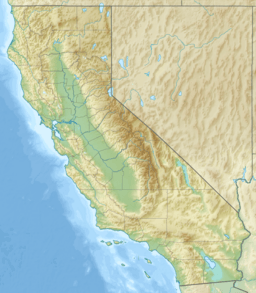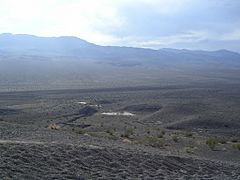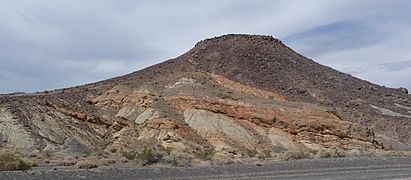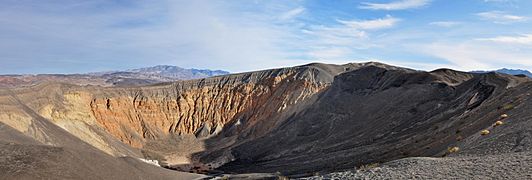Ubehebe Craters facts for kids
Quick facts for kids Ubehebe Craters |
|
|---|---|
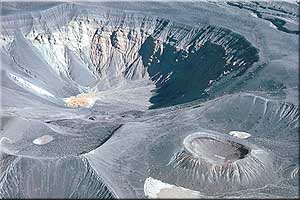
View onto Ubehebe Crater and Little Hebe Crater
|
|
| Highest point | |
| Elevation | 752 m (2,467 ft) |
| Naming | |
| Etymology | Etymology |
| Geography | |
| Parent range | Death Valley, Basin and Range Province |
| Geology | |
| Age of rock | Holocene |
| Mountain type | Volcanic field |
| Last eruption | 150 BCE? |
| Climbing | |
| Access | Death Valley National Park |
The Ubehebe Craters are a group of cool holes in the ground in California. You can find them in the northern part of Death Valley. There are about 14 to 16 craters spread over an area of 3-square-kilometre (1.2 sq mi).
The biggest one is called Ubehebe Crater. It is 800 metres (2,600 ft) wide and 235 metres (771 ft) deep. Some of the other craters are partly hidden and hard to see. You can also find a small part of an old scoria cone and a tuff cone here.
The Ubehebe Craters sit on top of a fault system. This means there are cracks in the Earth's crust underneath them. The area has had volcanoes for the last 10 million years. These craters are part of the Death Valley National Park. Visitors can easily reach them.
Scientists have guessed different ages for the craters. New research shows that all the Ubehebe Craters formed at once. This happened about 2,100 years ago. It was a special type of eruption called a phreatomagmatic eruption. This makes it one of the newest volcanic events in southern California. But don't worry, the chance of new eruptions is very low.
Contents
What's in a Name?
The name "Ubehebe" is said as YOU-bee-HEE-bee. No one is really sure what it means. It might mean "woman's breast" in the Owens Valley Paiute language. Some people wrongly think it means "big basket."
The local Shoshone tribes have their own name for it. They call it "Tempintta Wosah." This means "basket in the rock" or "coyote's basket." This name describes the shape of the main crater. People first noticed these volcanoes in 1932.
Where Are the Craters?
The Ubehebe Craters are in northern Death Valley. They are on the side of Tin Mountain. This mountain is part of the Panamint Range and Cottonwood Mountains. They are about 100 kilometres (62 mi) from Furnace Creek. They are also about 230 kilometres (140 mi) from Las Vegas.
The area around the craters has many hills. These are known as the Ubehebe Hills. A small stream, called a wash, flows north about 2 kilometres (1.2 mi) from the main crater.
Crater Shapes and Sizes
The main volcano is 752 metres (2,467 ft) high. It has two main maars, which are wide, flat-bottomed craters. These are Ubehebe Crater and Little Hebe Crater. Little Hebe is just south of Ubehebe Crater.
There are 14 to 16 craters in total. They cover an area of 3 square kilometres (1.2 sq mi). Most of them are about 100–200 metres (330–660 ft) wide. The craters are grouped into four main areas. Many of them are worn down by weather. Some are even buried by dirt and rocks. This makes them hard to spot.
Ubehebe Crater: The Big One
Ubehebe Crater is the biggest crater here. It is a tuff ring-maar. It is 800 metres (2,600 ft) wide and 235 metres (771 ft) deep. It dug deep into the ground when it formed.
The inside walls of the crater look different on each side. This is because a fault line runs through it. You can see places where the ground has slid down. There are also gullies from water erosion. Big piles of rock debris are also visible. The largest one is 200 metres (660 ft) long and 100 metres (330 ft) wide.
Sometimes, a playa lake forms at the bottom of the crater. The edge of the crater is covered in black volcanic ash. Volcanic rocks around the crater can be 50 metres (160 ft) thick. They get thinner the further you go. Sometimes, you can see Scorpionweeds and sundrop flowers growing near the edge.
Little Hebe and Other Craters
Little Hebe Crater is a tuff cone. Its crater is 100 metres (330 ft) wide and 20 metres (66 ft) deep. It is surrounded by special rock deposits. These deposits have cool black and white stripes. Little Hebe seems to have formed inside a long dip in the ground. This dip is called the "Amphitheater."
Between this dip and Ubehebe Crater, you can find parts of an old scoria cone. Other craters are west of Ubehebe Crater. One more crater is by itself to the southwest. Only Ubehebe Crater seems to have dug down to the very old rock layers. The other craters are mostly in the volcanic ash.
Volcanic ash and rocks flew up to 4 kilometres (2.5 mi) away from Ubehebe Crater. They covered an area of about 15 square kilometres (5.8 sq mi). The layer of ash was less than 50 metres (160 ft) thick. These deposits are called base surges. They form when hot magma and water mix and explode.
The deposits have wave-like patterns. These look like ripples in the sand. You can see them where streams have cut through the ground. Or where roads have been built. Rocks up to 15 centimetres (5.9 in) big are mixed in these deposits. The deposits are covered by volcanic ash, small rocks called lapilli, and lava bombs.
How the Craters Formed
Death Valley is part of the Basin and Range Province. This area has many parallel mountain ranges and valleys. For about 10 million years, volcanoes have been active around Death Valley. This activity created the Ubehebe Craters.
The Ubehebe Craters formed in soft, layered rocks. These rocks can be seen inside the craters. Under Ubehebe Crater, there are layers of conglomerate and sandstone. These layers are about 0.5-kilometre-thick (1,600 ft). They are part of a rock group called the Navadu Formation.
The Ubehebe Craters sit on top of a fault line. This fault marks the edge of the Tin Mountain range. Near the craters, the fault has created steep drops in the land. This fault is also called the Tin Mountain fault. It cuts right through Ubehebe Crater. It also branches into other smaller faults.
What Are the Rocks Made Of?
The Ubehebe Craters erupted alkali basalt and sideromelane. These are types of volcanic rock. Inside these rocks, you can find small crystals. These include augite, clinopyroxene, kaersutite, olivine, and plagioclase.
The volcanic rocks from different vents are very similar. This means the magma came from the same deep source. This source is in the Earth's mantle under the Mojave area. The eruptions also threw out pieces of older rocks. These included gneiss, quartz, and syenite. These pieces are scattered around the craters.
Weather at the Craters
Summer temperatures at the Ubehebe Craters can get very hot. But in winter, temperatures often drop below freezing. During a cold period long ago, called the Little Ice Age, it was cold enough for snow to stay in the craters. This snow shaped the land.
Today, Death Valley gets about 56 millimetres per year (2.2 in/year) of rain. The amount of rain changes a lot each year. Rain usually comes in sudden downpours. These can cause a lot of erosion. Sometimes, temporary lakes form in the craters after heavy rain.
The volcanic eruptions at Ubehebe Craters used a lot of water. This might make you think it was wetter back then. But scientists later found that the craters formed during a dry period. This means only a small amount of groundwater was needed for the explosions.
When Did the Craters Erupt?
The Ubehebe Craters are considered to be from the Holocene age. This is the current geological period. They formed in one big event about 2,100 years ago. This was around 150 BCE. Scientists figured this out using special dating methods. These include archeomagnetic dating and radiometric dating.
This makes Ubehebe Craters the most recent basaltic eruption in the United States. It is also one of the youngest in southern California. Older guesses for the age of the craters were very different. Some thought they were millions of years old.
How the Eruption Happened
The eruptions started with the formation of a scoria cone. Later, the activity became hydrovolcanic. This happened when the magma mixed with water. This caused huge steam explosions. These explosions formed the two groups of craters. The "Amphitheater" formed first. Then came the western craters. Ubehebe Crater was the last to form.
The explosion that created Ubehebe Crater was very powerful. It was like at least 1 petajoule (280,000,000 kWh) of energy. Broken lava and rocks were blasted high into the air. They covered an area of 39 square kilometres (15 sq mi) when they fell. Hot, fast-moving clouds of gas and ash, called base surges, shot out from the craters. They followed the shape of the land.
For Little Hebe Crater, it seems like something blocked the crater early on. Then it was violently blown out. This left a ring of bubbly volcanic rock around the crater. The whole eruption event lasted only a few days or weeks. At most, it lasted a few months. Ash from the eruption fell on nearby Shoshone communities. The eruption would have been amazing to see. But local people's stories don't mention it.
After the eruptions, water carved gullies into the volcanic ash. These followed old stream paths. This showed off the layers of volcanic rock. Temporary crater lakes formed in some craters. They left behind clay deposits. Today, the main Ubehebe Crater sometimes has water in it.
Visiting the Craters
A paved road goes north and west of Ubehebe Crater. There is a parking lot right on its rim. A trail goes around the edge of the crater. Another path goes down to the bottom of the crater.
Tourists have been visiting the Ubehebe Craters for a long time. The volcanoes are in the northern part of Death Valley National Park. The desert views of the craters are very beautiful.
Safety and Monitoring
Scientists recently found out how young the Ubehebe Craters are. This led the California Volcano Observatory to start watching them. They put in a seismometer to check for ground movement.
The volcano is called a "Moderate Threat" volcano by the USGS. This means there's some risk, but not a high one. Scientists have drawn a hazard zone around the craters. This zone is about 10-kilometre-wide (6.2 mi). It reaches Scotty's Castle. If new eruptions happened, hot ash clouds and steam blasts could reach this area.
Future eruptions could affect the almost one million people who visit Death Valley National Park each year. They could also affect the about 100 people who live nearby. However, these craters likely formed in just one event. This means the chance of new eruptions is low.


